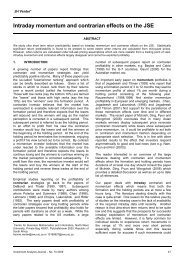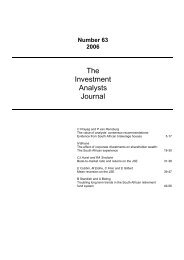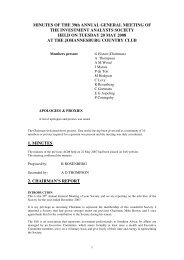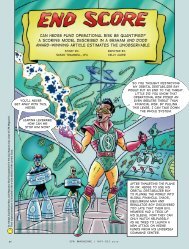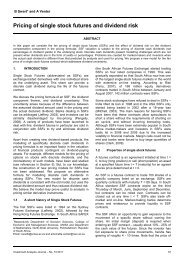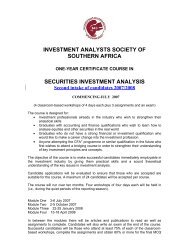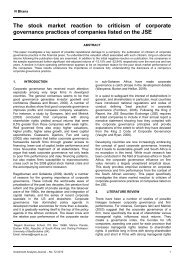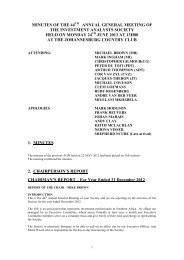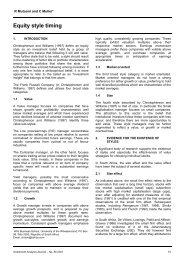Accounting is Broken - Investment Analysts Journal
Accounting is Broken - Investment Analysts Journal
Accounting is Broken - Investment Analysts Journal
You also want an ePaper? Increase the reach of your titles
YUMPU automatically turns print PDFs into web optimized ePapers that Google loves.
Stern Stewart & Co.<br />
D<strong>is</strong>closure would give investors important additional information to determine a firm’s<br />
overall cost of capital and its value. The d<strong>is</strong>closed targets are apt to be credible in the main<br />
because investors, analysts and the media will hold managers’ feet to the fire if they do not<br />
achieve their espoused objectives over time.<br />
Absent that policy change auditors could use a company’s trailing three-year average<br />
debt/equity mix as the implied target. The trailing average <strong>is</strong> simple and auditable, and will<br />
c e rtainly be more accurate than taking any one year’s leverage ratio at face value. By divorcing<br />
dec<strong>is</strong>ions from transitory appearances, it will encourage managers to deploy capital in the<br />
long run interests of shareholders. And it will let managers happily live in one world instead<br />
of two, the world of legitimate value creation as opposed to that of financial manipulation.<br />
The accounting ru l e s<br />
for defined-benefit pension<br />
plans are almost<br />
totally incorre c t .<br />
The root of the pro b l e m<br />
<strong>is</strong> that accountants do<br />
not treat pension<br />
accounts as true corporate<br />
liabilities and assets<br />
when in fact they are .<br />
Pension Plan <strong>Accounting</strong> Wrongly Mixes Operating Costs and<br />
Financial Return s<br />
The accounting rules for defined-benefit pension plans are almost totally incorrect. The<br />
gap between appearance and economic substance <strong>is</strong> probably as far apart in th<strong>is</strong> <strong>is</strong>sue as any<br />
o t h e r. Accountants intertwine the pension cost with how it <strong>is</strong> funded. They systematically<br />
understate the expense of paying for a re t i rement plan. They ignore and smooth r<strong>is</strong>k. The<br />
bookkeepers have seduced usually staid finance managers into being far too adventure s o m e<br />
with their pension fund assets. Almost all companies today are running far too great a r<strong>is</strong>k<br />
of joining GM and having to hand over more cash to their pension plan just after the market<br />
has taken a nose dive and they are least pre p a red to make the extra payments:<br />
Despite favorable performance, GM chief Financial Officer John Devine said most of the<br />
$3.5 billion in cash the company generated in its auto business in the latest quarter went to<br />
fund contributions for retiree costs. Depending on how the markets perform, he said, GM<br />
might have to contribute $6 to $9 billion to its pension plan over the next five years to meet<br />
regulatory requirements.<br />
GM’s shares, which have fallen sharply in the past few weeks amid concerns about the pension-fund<br />
<strong>is</strong>sue, fell 4.3% to $45.84 on the New York Stock Exchange.<br />
GM Profit Grows, But Pension Costs worry Investors<br />
The Wall Street <strong>Journal</strong><br />
July 17, 2002, page A3<br />
Whether paid out of<br />
cash flow or in bankru<br />
p t c y, a company’s pension<br />
liability <strong>is</strong> senior<br />
even to its most senior<br />
l e n d e r s .<br />
The root of the problem <strong>is</strong> that accountants do not treat pension accounts as true corporate<br />
liabilities and assets when in fact they are. For starters, ERISA 8 regulations re q u i re a company<br />
to maintain minimum funding of its future pension liabilities out of its on-going cash<br />
flows (hence GM’s urgency to bump up its pension contributions). If a company <strong>is</strong> caught<br />
s h o rt and goes belly-up without a fully funded plan, the shortfall <strong>is</strong> covered by a govern m e n t<br />
insurance fund, the Pension Benefit Guarantee Corporation. Employees do not need to lose<br />
sleep in a bankruptcy filing, but the firm ’s lenders must. The PBGC <strong>is</strong> empowered to re c o v-<br />
er its advance by filing a claim against the company’s assets that has the status of a tax lien.<br />
Whether paid out of cash flow or in bankruptcy, a company’s pension liability <strong>is</strong> senior even<br />
to its most senior lenders. It <strong>is</strong> not a vague contingent claim that deserves to be relegated<br />
to a footnote—the bookkeeper’s equivalent of ban<strong>is</strong>hment to Siberia. The pension liability<br />
<strong>is</strong> in fact the exact opposite—a liability so emphatic it should be boldly printed on a company’s<br />
balance sheet at the very top of its l<strong>is</strong>t of debts. Although they are actually in the<br />
control of a trustee, and are legally segregated for the benefit of servicing the employee<br />
retirement benefits, a company’s pension fund assets are truly corporate assets because they<br />
d i rectly offset the firm ’s pension liability. They, too, should appear on the corporate b a l a n c e<br />
8<br />
The Employee Retirement Income Security Act (ERISA) was enacted to ensure that employees receive the pension and other benefits<br />
prom<strong>is</strong>ed by their employers.<br />
10




